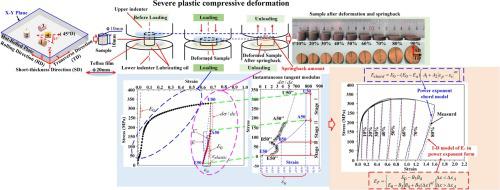当前位置:
X-MOL 学术
›
J. Mater. Process. Tech.
›
论文详情
Our official English website, www.x-mol.net, welcomes your
feedback! (Note: you will need to create a separate account there.)
Springback behavior and a new chord modulus model of Copper alloy during severe plastic compressive deformation
Journal of Materials Processing Technology ( IF 6.7 ) Pub Date : 2021-04-01 , DOI: 10.1016/j.jmatprotec.2020.116974 Hongli Hou , Guoqun Zhao , Liang Chen , Huiping Li
Journal of Materials Processing Technology ( IF 6.7 ) Pub Date : 2021-04-01 , DOI: 10.1016/j.jmatprotec.2020.116974 Hongli Hou , Guoqun Zhao , Liang Chen , Huiping Li

|
Abstract The copper alloy in the unloading process after severe plastic compressive deformation (SPCD) exhibits obvious nonlinear stress-strain relationship and hysteresis behavior, and generates severe springback deformation. The severe strain hardening and softening effects occurring in the SPCD and the anisotropy of the material will affect the springback behavior of the material. In this paper, the samples obtained along the different directions (rolling direction, short-thickness direction, transverse direction, and 45° direction) of copper alloy hot-rolled plates were used to perform the quasi-static single pass compression tests with different deformation ratios (0.25%-90%). The springback behavior of the copper alloy under the SPCD was investigated. The effects of the strain hardening, strain softening and anisotropy on the springback behavior of the material were revealed. The variation relationships of the instantaneous tangent modulus and the chord modulus in unloading with stress and strain at different deformation stages (elastic stage, yield stage, strain hardening stage, and strain softening stage) were analyzed. A new chord modulus in a power exponential form was proposed. According to the unloading characteristic of the SPCD, the Yoshida-Uemori chord modulus model and the QPE model were modified. The applicability and accuracy of the unloading chord modulus models for the SPCD were evaluated and compared by using the power exponential chord modulus model, the modified QPE chord modulus model, the modified Yoshida-Uemori chord modulus model, and the Yoshida-Uemori chord modulus model, respectively. Besides, based on the proposed chord modulus model in a power exponential form, a 1-D E T model in a power exponential form was also proposed to describe the nonlinear unloading process and the variation of the slope of the unloading curves after the SPCD. The results indicated that the springback behavior of SPCD is obviously different from those of small plastic compressive deformation and elastic compressive deformation. The proposed chord modulus model in a power exponential form can accurately predict the chord modulus and springback strain in the unloading after the SPCD
中文翻译:

严重塑性压缩变形过程中铜合金的回弹行为及新的弦模量模型
摘要 铜合金在剧烈塑性压缩变形(SPCD)卸载过程中表现出明显的非线性应力应变关系和滞后行为,并产生剧烈的回弹变形。SPCD 中发生的严重应变硬化和软化效应以及材料的各向异性将影响材料的回弹行为。本文利用沿铜合金热轧板不同方向(轧制方向、短厚方向、横向、45°方向)获得的试样进行不同变形的准静态单道次压缩试验。比率(0.25%-90%)。研究了铜合金在 SPCD 下的回弹行为。应变硬化的影响,揭示了材料回弹行为的应变软化和各向异性。分析了不同变形阶段(弹性阶段、屈服阶段、应变硬化阶段和应变软化阶段)卸载时瞬时切线模量和弦模量随应力应变的变化关系。提出了一种新的幂指数形式的弦模量。根据SPCD的卸载特性,对Yoshida-Uemori弦模量模型和QPE模型进行了修正。分别采用幂指数弦模模型、修正QPE弦模模型、修正Yoshida-Uemori弦模模型、Yoshida-Uemori弦模模型,对SPCD卸载弦模模型的适用性和准确性进行了评价和比较, 分别。除了,基于提出的幂指数形式的弦模量模型,还提出了幂指数形式的1-DET模型来描述非线性卸载过程和SPCD后卸载曲线斜率的变化。结果表明,SPCD的回弹行为与小塑性压缩变形和弹性压缩变形的回弹行为明显不同。提出的幂指数形式的弦模量模型可以准确预测SPCD后卸载时的弦模量和回弹应变 结果表明,SPCD的回弹行为与小塑性压缩变形和弹性压缩变形的回弹行为明显不同。提出的幂指数形式的弦模量模型可以准确预测SPCD后卸载时的弦模量和回弹应变 结果表明,SPCD的回弹行为与小塑性压缩变形和弹性压缩变形的回弹行为明显不同。提出的幂指数形式的弦模量模型可以准确预测SPCD后卸载时的弦模量和回弹应变
更新日期:2021-04-01
中文翻译:

严重塑性压缩变形过程中铜合金的回弹行为及新的弦模量模型
摘要 铜合金在剧烈塑性压缩变形(SPCD)卸载过程中表现出明显的非线性应力应变关系和滞后行为,并产生剧烈的回弹变形。SPCD 中发生的严重应变硬化和软化效应以及材料的各向异性将影响材料的回弹行为。本文利用沿铜合金热轧板不同方向(轧制方向、短厚方向、横向、45°方向)获得的试样进行不同变形的准静态单道次压缩试验。比率(0.25%-90%)。研究了铜合金在 SPCD 下的回弹行为。应变硬化的影响,揭示了材料回弹行为的应变软化和各向异性。分析了不同变形阶段(弹性阶段、屈服阶段、应变硬化阶段和应变软化阶段)卸载时瞬时切线模量和弦模量随应力应变的变化关系。提出了一种新的幂指数形式的弦模量。根据SPCD的卸载特性,对Yoshida-Uemori弦模量模型和QPE模型进行了修正。分别采用幂指数弦模模型、修正QPE弦模模型、修正Yoshida-Uemori弦模模型、Yoshida-Uemori弦模模型,对SPCD卸载弦模模型的适用性和准确性进行了评价和比较, 分别。除了,基于提出的幂指数形式的弦模量模型,还提出了幂指数形式的1-DET模型来描述非线性卸载过程和SPCD后卸载曲线斜率的变化。结果表明,SPCD的回弹行为与小塑性压缩变形和弹性压缩变形的回弹行为明显不同。提出的幂指数形式的弦模量模型可以准确预测SPCD后卸载时的弦模量和回弹应变 结果表明,SPCD的回弹行为与小塑性压缩变形和弹性压缩变形的回弹行为明显不同。提出的幂指数形式的弦模量模型可以准确预测SPCD后卸载时的弦模量和回弹应变 结果表明,SPCD的回弹行为与小塑性压缩变形和弹性压缩变形的回弹行为明显不同。提出的幂指数形式的弦模量模型可以准确预测SPCD后卸载时的弦模量和回弹应变











































 京公网安备 11010802027423号
京公网安备 11010802027423号